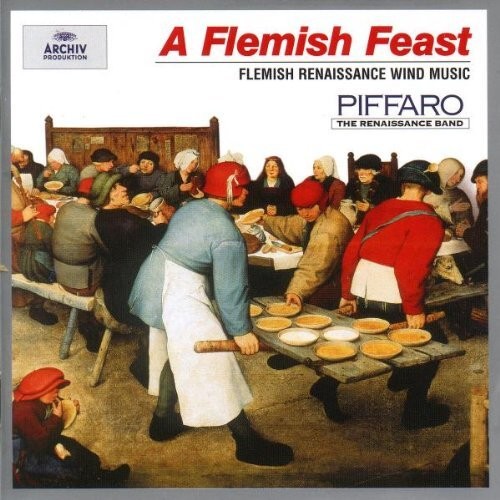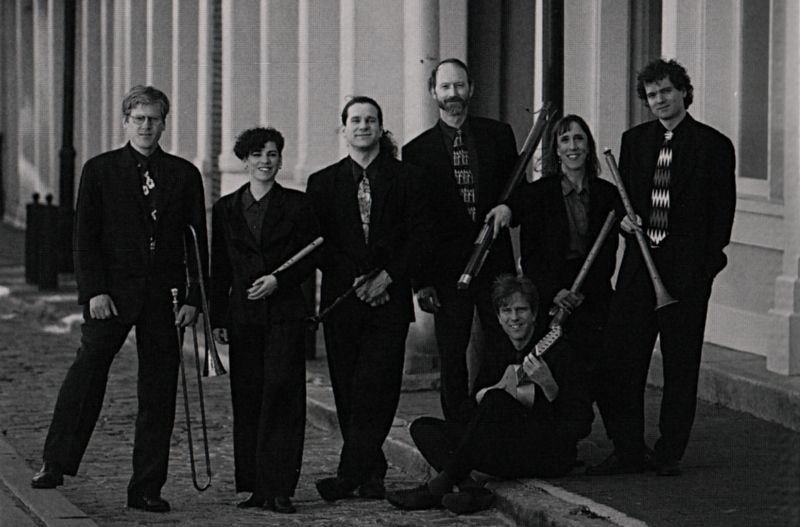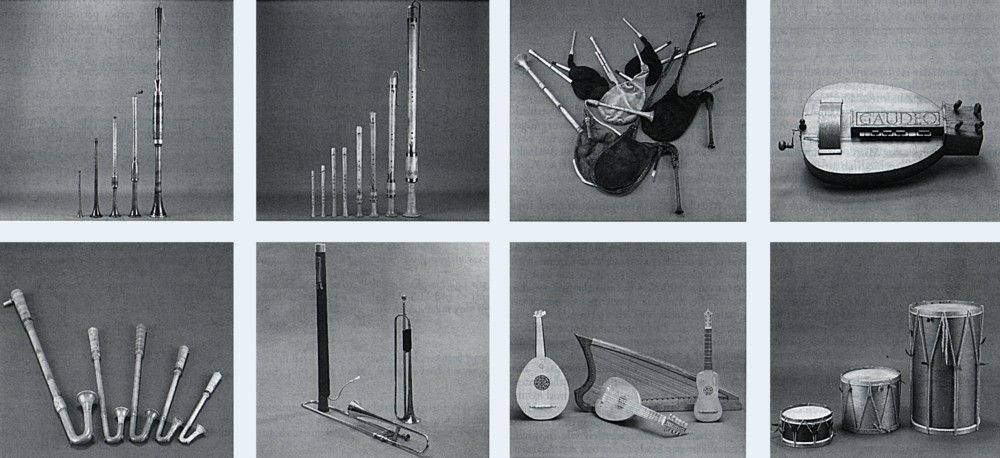A Flemish Feast / Piffaro
Flemish Renaissance Wind Music

medieval.org
amazon.com
DGG Archiv Produktion 457 609-2 AH
1999
1. Anonymous flemish melodies, 15th & 16th c. [5:30]
T'andernaken
Laet ons mit hartzen
Hoboekentanz
Laet ons mit hartzen
Ihesus is een kyndekyn cleyn
Laet ons mit hartzen
bagpipes (AG, TZ, JK), soprano recorder (RG), guitar (GH), tambourine (RW), drum (GHoyt)
source: Florimond van Duyse, Het oude Nederlandsche lied (The Hague, 1903-08)
Pierre de la RUE (c.1460—1518)
2. Ave regina caelorum [2:36]
D soprano shawm (AG), sackbuts (GHoyt, TZ), dulcian (RW)
source: London, British Museum, MS Roy 8 G VII, fol. 8v-10v
edition: Pierre de La Rue: Opera Omnia, ix [CMM 97], Nigel St. John Davison, ed. (Rome, 1996)
3. Pourquoy non [2:01]
sackbuts (GHoyt, TZ), tenor shawm (GH), dulcian (RW)
source: Harmonice Musices Odhecaton A (Venice, Ottaviano Petrucci, 1501), fol. 17v-18
Tylman SUSATO (c.1500?—c.1561?)
4. Passe et medio & reprise [2:18]
sackbut (GHoyt), tenor shawm (JK), sackbut (TZ), dulcian (RW)
5. [2:10]
Gaillarde
D soprano shawm (AG), tenor shawm (JK), G alto shawm (RG), dulcian (RW), percussion (GH)
Gaillarde
bagpipes (TZ), percussion (GH)
Gaillarde
D soprano shawm (AG), bagpipes (TZ), percussion (GH)
6. La Morisque [1:31]
D soprano shawm (AG), G alto shawm (RG), tenor shawm UK), sackbut (GHoyt), bagpipes (TZ), dulcian (RW), percussion (GH)
source: T. Susato, Het derde musyck boexken (Antwerp, 1551)
Jacob OBRECHT (c.1450—1505)
7. J'ay pris amours [4:32]
G alto recorder (AG, RG), tenor recorder UK), F bass recorder (RW)
source: Canti B (Venice, Ottaviano Petrucci, 1501-02), fol. 3v
8. J'ay pris amours [1:25]
lute (GH), harp (TZ)
source: written and arr. by Grant Herreid after the chanson tune (All rights reserved)
Alexander AGRICOLA (1446—1506)
9. Crions Noel [1:28]
G alto recorder (RG), lute (GH), harp (TZ)
source: Harmonice Musices Odhecaton A, (Venice, Ottaviano Petrucci, 1501), fol. 81v-82
Erasmus LAPICIDA (c. 1445—1547)
10. T'andernaken [2:23]
G alto recorder (RG), tenor recorder (AG), lute (GH)
source: Canti C (Venice, Ottaviano Petrucci, 1503-04), fol. 152v-153v
Jacob OBRECHT
11. Laet u ghenoughen, liever Johan [1:42]
G alto recorder (AG, RG), tenor recorder (JK), F bass recorder (RW), harp (TZ), lute (GH)
source: Segovia, Archivo Capitular de la Catedral, MS Ss. (c.1495-1503), fol. 119v-120r
edition: Jacob Obrecht: Opera Omnia, editio altera, vii,
A. Smijers & M. van Crevel, eds., UVNM (1969), p. 90
Tylman SUSATO
12. Entre du fol [1:50]
13. Mon désir [1:24]
hurdy-gurdy (TZ), lute (GH)
source: T. Susato, Het derde musyck boexken (Antwerp, 1551)
Johannes GHISELIN (fl. early 16th c.)
14. Je loe amours
[2:20]
D soprano shawm (AG), G alto shawm (RG), sackbut (GHoyt)
source: Canti C (Venice, Ottaviano Petrucci, 1503-04), fol. 138v-140
Pierre ALAMIRE (c.1475—after 1534)
15. T'andernaken [2:46]
G alto shawm (JK), sackbuts (GHoyt, TZ), dulcian (RW)
source: Vienna, Österreichische Nationalbibliothek, Mus. MS 18810, no. 28
Alexander AGRICOLA, Johannes GHISELIN
16. Untitled duo [2:07]
sackbuts (GHoyt, TZ)
source: Perugia, Biblioteca Augusta, MS 1013 (M36), fol. 137v-138r
edition: Alexander Agricola: Opera Omnia, v [CMM 22]1,
Edward R. Lerner, ed. (Rome, 1970)
anonymous
17. De tous biens playne [1:20]
D soprano shawm (AG), slide trumpet (TZ), G alto shawm (JK), sackbut (GHoyt)
source: Canti C (Venice, Ottaviano Petrucci, 1503-04), fol. 88v-89r
Tylman SUSATO
18. Pavane & Gaillarde 'La dona' [2:06]
G alto crumhorn (RW), tenor crumhorn (GHoyt, RG), bass crumhorn UK)
source: T. Susato, Het derde musyck boexken (Antwerp, 1551)
anonymous
19. Wij sheyt edel vrouwe [1:30]
lute (GH)
source: Florimond van Duyse, Het oude Nederlandsche lied (The Hague, 1903-08); arr. Grant Herreid
Tylman SUSATO
20. Allemaigne [1:43]
lute (GH)
21. 4 Bransles [0:58]
22. Bergerette [1:41]
bagpipes (AG, RG, JK)
source: T. Susato, Het derde musyck boexken (Antwerp, 1551)
Jacob CLEMENS non Papa (c. 1510—1555)
23. O Crux benedicta [3:04]
G alto recorder (AG), tenor recorder (RG), G bass recorder [basset] (RW), C bass recorder [great bass] (JK)
source: Clemens non Papa: Liber primas cantionum sacrarum
(Louvain, Pierre Phalèse, 1559), [RISM 1559f]
edition: Clemens non Papa: Opera Omnia [CMM 50], xviii,
K. P. Bernet Kempers, ed. (Rome, 1969)
24. Ave mundi spes Maria [3:41]
G alto recorder (AG), tenor recorder (RG, TZ), G bass recorder (RW), F bass recorder (GH), C bass recorder (JK)
source: Sacrarum cantionum... Liber primus
(Antwerp, Hubert Waelrant St. Jean de Laet, 1554) [RISM 15546]
edition: cf. #23, xv, 24
TYLING (fl. c. 1450—1475)
25. T'andernaken al op den Rijn [1:52]
D soprano shawm (AG), G alto shawm OK, RG)
source: Trento, Castello del Buon Consiglio, MS 87
edition. B. Disertori, Tyling musico inglese nei codici trientini,
Studi Trentini di scienze storiche, xxxvi (Trento, 1957), p. 10
Johannes PULLOIS (d.1478)
26. Les larmes [2:02]
sackbut (GHoyt), tenor shawm (GH), sackbut (TZ)
source: Trento, Castello del Buon Consiglio, MS 90, fol. 300v (no. 1015)
edition: J. Pullois: Opera Omnia [CMM 41], Petrus Gülke, ed. (Rome, 1967)
Johannes BRASSART (fl. 1420—1445)
27. Fortis cum quevis actio [4:07]
D soprano shawm (AG, RW), G alto shawm (RG, JK)
source: Oxford, Bodleian Library, Cod. Canonici misc. 213, fol. 131v-132
edition: J. Brassart: Opera Omnia, ii [CMM 35], K. E. Mixter, ed. (Rome, 1971)
anonymous
28. Die winter is verganghen [2:26]
bagpipes (JK, AG, RG)
source: Florimond van Duyse, Het oude Nederlandsche lied (The Hague, 1903-08)

Piffaro
The Renaissance Band
Joan Kimball & Robert Wiemken, directors
Adam Gilbert (AG), Rotem Gilbert (RG),
Grant Herreid (GH), George Hoyt (GHoyt), Joan Kimball (JK),
Robert Wiemken (RW), Tom Zajac (TZ)
Recording: Mandelsloh, Neustadt, Lower Saxony (Germany),
St. Osdag Kirche, 6/1997
Executive Producer: Dr. Peter Czornyj
Recording Producer: Sid McLauchlan
Tonmeister (Balance Engineer) & Recording Engineer: Andrew Wedman
Ⓟ 1999 Deutsche Grammophon GmbH, Hamburg
© 1999 Deutsche Grammophon GmbH, Hamburg
Cover Illustration: "Farmer's Wedding" (detail), painting by Pieter Brueghel the Elder
Photo: Prof. Erich Lessing/Kunsthistorisches Museum, Wien
Archiv für Kunst und Geschichte, Berlin
Photos: © 1997/99 Joe Chielli
Art Direction: Lutz Bode
Printed in Germany by/Imprimé en RFA par Münstermann, Hannover

A Flemish Feast
Instrumental music sounded in every corner of Flanders during the
Renaissance. Fiddles, shawms, bagpipes and trumpets played an integral
part in the lives of nobility, priests, city dwellers and peasants
alike. This phenomenon did not, of course, occur everywhere in equal
quantity or quality: the restrained elegance of the lute, for example,
was more likely to be heard in the private chambers of the aristocracy
and the urban elite than in the fields accompanying the frenetic
dancing at a peasant wedding. But in any Flemish celebration or ritual,
instruments and instrumental music were an indispensable element.
This collection of Flemish music reflects the wide variety of music and
instrumental effects that resounded throughout the Low Countries in the
15th and 16th centuries. The repertory performed here gives an idea of
the extraordinary quality of Flemish composers of the era, and also
conveys a sense of the different contexts in which music was heard and
enjoyed. Peasants, for instance, would have been more familiar with the
sounds of the bagpipe and hurdy-gurdy - their music was relatively
straightforward in its rhythmic and melodic appeal, as can be heard in
several of the dance settings of Tylman Susato. The shawm bands were a
particular pride of civic authorities, whose music is typified here by
the settings of Ghiselin and Alamire. The recreation of the nobility,
as already suggested, was as likely accompanied by lutes and recorders,
heard here in settings by Obrecht and Agricola.
The Players, the Composers and their Repertory
The anthology opens with a group of anonymous Flemish melodies. Tunes
like these made up the building blocks of Renaissance music-making and
could be performed in a number of different ways: as unaccompanied
melodies, either left unadorned or embellished, or with added voices
and either simple chordal accompaniments or elaborate, often improvised
counterpoint. And they were played at a variety of venues and
occasions: at outdoor village festivals in summer (as might have been
the case with the Hoboekentanz), in city banqueting halls (Laet
ons mit hartzen), in castle chambers (T'andernaken) and
churchyards (Jhesus is een kyndekyn cleyn).
Ordinances laying out the duties of town bands in Flanders directed
them to play regular afternoon performances for the populace, and these
were to include both sacred and secular pieces. A description of one
such performance in Bruges mentions an Ave regina caelorum -
the four-part setting of this motet by Pierre de La Rue might well have
been heard in that performance, as well as his secular song Pourquoy
non, which follows. In both works the composer exploits the
contrast of texture between sections marked by transparent imitation
and others featuring more choral writing - an effect that works
especially well in instrumental performance. La Rue was active from
about 1480 to 1518, and spent much of his life in court service of the
Habsburgs, with Maximilian I, Philip the Fair, and finally, in Mechelen
with Margaret of Austria. This position brought him into contact with
some of the finest performers of the age, including the superb
cornettist Augustin Schubinger and the fine trombonist Hans Nagel.
The next group of dances was arranged (and probably composed) by Tylman
Susato, who began his career in Antwerp in 1529 as a trombonist and
colleague of Hans Nagel. Susato subsequently established one of the
most successful publishing firms of the century, for which he not only
served as an editor and transcriber, but frequently composed pieces as
needed. He published several volumes designed specifically for the
Flemish market, including the set of dances contained in the Derde
Musyck Boexken [the Third Music Book]. In these charming pieces the
tunes usually predominate, but the Passe et medio is an early
example of a structure based on the repetition of a bass pattern.
Jacob Obrecht's settings of popular tunes begin and end the next group.
In his own J'ay pris amours, the tune wanders from voice to
voice (from the soprano, where it can be clearly heard, to the bass,
alto and finally the tenor), surrounded by dense, figural counterpoint.
Obrecht had heard fine instrumental playing during his youth in Ghent,
where his father was a famous trumpet player, and subsequently he
worked in close quarters with some of the best musicians of the era. In
Ferrara, for example, where he held his last position, one of the
outstanding shawm players at court was Michele Tedesco, otherwise known
as Michael Schubinger, brother of Augustin mentioned above. The new
arrangement by Grant Herreid of J'ay pris amours vividly
illustrated the way a late 15th century musician might have embellished
the tune spontaneously in performance.
Alexander Agricola worked within circles similar to those of Obrecht.
He began his career in Italy and spent some time at the French court
before taking up his final position as a composer and singer for Philip
the Fair, Duke of Burgundy and King of Castile. The Burgundian court
choir included La Rue, and among the wind players who performed with
the ensemble were Nagel and Augustin Schubinger. Agricola's Crions
Noel is a reminder that the French chanson was a staple of the
international repertory heard in the cosmopolitan courts of Flanders.
Johannes Ghiselin (a Fleming who, like Agricola, worked at the French
court and later served in Ferrara as a colleague of Obrecht) placed the
tune of Je loe amours (the original is a setting of a
melancholy courtly text) in the tenor. The two outer voices engage in
charming, tight imitations of each other, with sharply defined motives
that make the interplay easy to hear.
Pierre Alamire (Pieter van den Hove) was one of the most famous scribes
of his time. His workshop produced quantities of elegant manuscripts
for the luxury market, with clients including Maximilian I and Margaret
of Austria. Although he was not well known as a composer (he did
achieve some notoriety as a spy for the court of Henry VIII of England,
where his colleague in skullduggery was the trombonist Hans Nagel), his
setting of T'andernaken reveals a sure hand. The tune is
embellished in the tenor and provided with dense, but surprising clear
imitative counterpoint.
Two motets by Clemens non Papa provide an example of the Netherlandish
style of imitation as it had evolved by the mid-16th century. Clemens
was closely associated with Susato in Antwerp, who published several
volumes that included his works. Finally, a group of pieces by Tyling,
Pullois and Brassart exhibits techniques of about a century earlier:
all these composers were active toward the middle of the 15th century.
Pullois was probably a Fleming (he worked in Antwerp much of his
career); Tyling is a shadowy figure, and the fact that he chose to set
the T'andernaken tune suggests that he too may have been of
Flemish origin. Brassart evidently hailed form the diocese of
Liège, but he probably finished his career in the Dutch-speaking
town of Tongeren.
The last selection, a free instrument version of the tune Die
winter is verganghen, demonstrates the flexibility which was
expected of Renaissance performers. Their craft required them to know
the works of the major composers of the day, but they were also
expected to be able to create new structures of their own. Theirs was a
dynamic, vital art.
Keith Polk

THE INSTRUMENTS
1. THE SHAWM FAMILY
The
shawm was the most important professional wind instrument of the time.
It was played with a double reed and had an widely expanding conical
bore and a brilliant, penetrating tone. During the Renaissance six sizes
were available, ranging from sopranino to great bass.
2. RECORDER CONSORT
The
recorder was an important wind instrument for consort use in the
Renaissance. With a beak mouthpiece, it has seven finger-holes at the
front and a thumb-hole at the back. The larger members of the family
have a soft expressive tone.
3. CRUMHORN CONSORT
The crumhorn
("curved horn") was the chief wind-cap instrument of the Renaissance.
Its double reed was covered by a cap fitting over the top of the
instrument, and thus the player's lips made no direct contact with it.
It has a narrow cylindrical bore, which produces a buzzing, slightly
nasal tone.
4. DULCIAN · SACKBUT · SLIDE TRUMPET
The dulcian
has a double reed and an expanding double bore. It emerged in the second
quarter of the 16th century in response to the demand for a deep
instrument in the wind band that was more agile, louder and easy to
handle.
The sackbut has a cup-shaped mouthpiece and a telescopic
slide like the trombone. Enormously versatile and agile, it had a full
chromatic compass and expressive tone.
The slide trumpet historically
occupied a place between the straight or S-shaped trumpet and the
sackbut or trombone. Presumably, the entire instrument moved on a single
slide attached to the mouthpiece. Cumbersome though it must have been
to play, it apparently took a significant role in the alta band
literature, playing the more florid contratenor lines.
5. BAGPIPES
Bagpipes
varied enormously in size and appearance, but all have a bag or
reservoir of air filled by a blowpipe, at least one drone pipe and a
chanter or melody pipe with double or single reed.
6. HURDY-GURDY
The
hurdy-gurdy was the earliest mechanized string instrument to which the
keyboard principle was applied. The bow is replaced by a wheel, cranked
by hand, which produces a continuous sound from all the strings. The
fingering is also mechanized, the melody string being stopped at
different points to produce different notes.
7. LUTE · GUITAR · HARP
The
lute was a plucked string instrument played with a plectrum in earlier
periods or with the fingers later in the Renaissance, making it capable
of performing complex polyphony on a single instrument. It was
cultivated by the nobility and enjoyed enormous popularity throughout
Europe, except in Spain where the vihuela was preferred.
The Renaissance guitar was pitched a fourth higher than the modern guitar and was usually strummed to accompany dance music.
The harp was of light construction with gut strings numbering about 25.
8. DRUMS & TABOR
Many
types of drum existed in the Renaissance, usually with thick,
low-tension skin heads secured to the shells with ropes. The tabor was
played with a simple single-stick technique and was often associated
with the three-holed pipe.
THE INSTRUMENTS
Shawms
sopranos in D: Joel Robinson, Robinson & Ross Woodwinds, New York, 1997;
Steve Hammer, New York
sopranino, altos in G and E and tenor: John Hanchet, Essen, Germany, 1985, 1993
Recorders
Renaissance consort (soprano through contrabass): Adrian Brown, Bergesserin, France, 1993
Renaissance recorders (alto in G and tenors in C): Bob Marvin, Eustis, Maine, 1995
Crumhorns
Renaissance consort: Stefan Beck, Brussels, Belgium, 1990
Sackbuts
tenors in B flat: John Webb, London, England, 1991; Christopher Monk, Surrey, England, 1987
Slide trumpet
instrument in D: Terry Pierce, New York, 1991
Dulcians
bass dulcian in F: Philip Levin, Levin Historical Instruments, Newfoundland, New Jersey, 1987
Bagpipes
Renaissance model in G or D: Joel Robinson, Robinson & Ross Woodwinds, New York, 1980-89
medieval pipes in G (conical bore): Paul Beekhuizen, The Hague, 1994
Hummelchen in F: Paul Beekhuizen, The Hague, Holland, 1994
pipes in G, (conical bore): Fritz Heller
Hurdy-gurdy
Renaissance model: Lyn Elder Workshop, San Rafael, California
Harp
Gothic model: Lynn Lewandowski, Brattleboro, Vermont, 1994
Lutes
plectrum lute 4-course in G: Richard Earle, 1981
Renaissance 6-course in A: Lawrence K. Brown, Washington, D.C., 1979
Guitar
4-course Renaissance model: Peter Forrester, England, 1981
Percussion
Virdung tabor, Arbeau tabor, hand drum, tambourines: Ben Harms, Historical Percussion, Great Barrington, Mass., USA, 1990s





